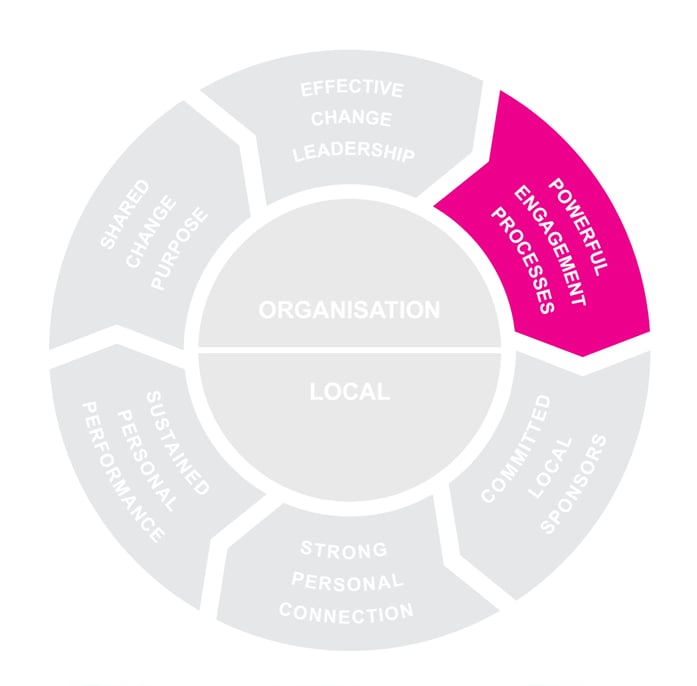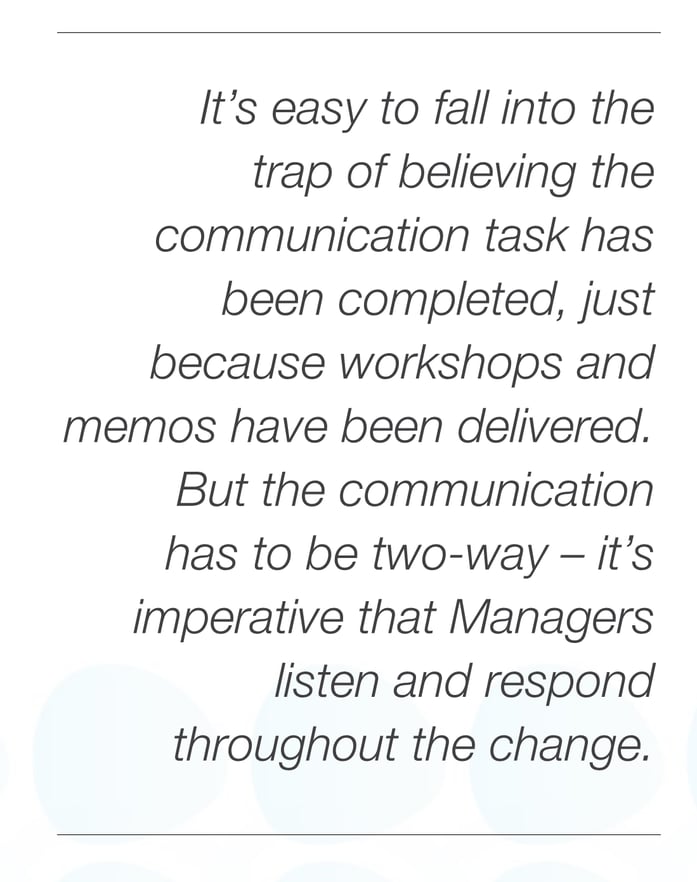
Creating, and maintaining, a powerful engagement process is the third organizational level critical success factor (CSF) for delivering successful business change. An effective engagement process goes beyond a communication strategy and a stakeholder map; it is comprised of four elements which work together; giving you the ability to truly engage with the people in your organization and help them adapt to and embrace the change.

The core elements of a powerful engagement process
We have spoken about the 4 organizational processes that make up an organizational engagement process before (read our series of engagement blogs from February here). They are:
- Involvement
- Learning
- Rewards
- Communication
Each of these process needs to be aligned with the others, and each need to support and reinforce the business change. This might seem like an obvious statement, but we often come across situations where one or more of these processes actually undermine the change management efforts rather than reinforce and enable the change.
Involvement needs to be meaningful
As well as helping people to maintain a sense of control, involvement is important for successful business change because you can create buy-in to the change. People are far more likely to adopt a process or any new way of working that they have had a part in designing.
But creating involvement at the wrong time, or for a generic issue, or without the ability to follow through, undermines the effectiveness of the involvement process and can create cynicism and resistance throughout the organization.
Think about these questions when you are designing your involvement process:
- Is there a specific issue the change project wants feedback and insight on?
- Are the right people being reached? Are the people who deal with this on a day to day basis involved?
- What will happen to the input generated, and how can this be made visible to the organization?
- Is the sponsor involved? Do the involvement mechanisms have clear leadership support and engagement?
Don’t forget learning!
Learning new skills and behaviors that allow individuals across the organization to work in the new way is a critical part of enabling your organization to understand and adapt to the business change.
Training is too often left until the last moment, quickly scheduled in just before a new system or process goes live. Learning does not need to be a slide based training session where participants are told about the change.
When learning is based around understanding the imperative for the change, and includes practicing the new behaviors required by the change, then learning becomes a very powerful tool for creating advocates for the business change.
Undertake an Initiative Legacy Assessment (ILA) and understand what types of learning has worked well in the past, and what has not worked so well. Your learning process needs to support the right type of learning for the change.
- Think about the delivery method: face-to-face, e-learning or a combination.
- Think about the participant mix: can you encourage cross-team collaboration.
- Focus on why this change is so important to the company, the imperative, rather than just what has changed.
Reward to support the change
A common problem during business change is that the organizational rewards and recognition processes support old behaviors.
Take the example of a Sales team who are undergoing a significant culture change towards working together as team, sharing leads and helping each other win business; but where the rewards and recognition program is still encouraging competition at an individual basis.
Understand upfront if the organizational reward process will conflict with the business change, and work with specialists in your organization who own the process to adapt the process to match the needs of the change. This is especially crucial when change is a constant in your organization.
Also think about how/why people are promoted. Do promotions reflect performance and behaviors that support the business change, or do promotion still reflect the old way of working?
Getting communication right
We have said it before and we will say it again, communication is more than just powerpoint slides or emails. Your communication process needs to facilitate meaningful two-way communication and discussions, throughout the whole change.
Communication is only one of the four engagement processes. It is often seen as the easiest element to do and therefore it is often over-used to the detriment of the other three engagement processes. Make sure your 4 engagement processes are in balance
Your engagement process is the cornerstone of both organization and local success
Remember that at the organizational level your processes need to be able to be adapted and used by your middle and front-line managers. Putting in place processes that work at the top level, which fail to translate into individual teams, or across different parts of the business, risks creating mis-alignment between the implementation of the business change across the organization.
Next week we will start to discuss the three local level CSFs. Complementing the three organizational CSFs, the local level focuses on where the change happens. Interested to read more? Our change management methodology incorporates the 6 CSFs, and identifies how they work together to drive through successful change.



Leave a comment